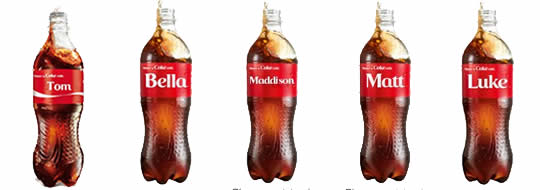Put Your Customer on the Product
Lately, I’ve highlighted the various ways companies (and even colleges) are putting their customers in their ads by using social personalization or other means. In Australia, Coke took the idea one step farther, and put customer names directly on its product:
Australians can pick up a personalised bottle or can at a supermarket, or get their name printed on a can of Coke for free at one of 18 Westfield Shopping Centres. At select outdoor sites, such as Kings Cross in Sydney, the names of passers-by will be projected on to the billboard via SMS. People will also be able to download one of 150 ‘name songs’, produced in partnership with Southern Cross Austereo. [Via Mumbrella.]

Here’s a video highlighting the “Share a Coke” campaign:
Sharing is Caring
The theme of the Coca Cola name promotion is “sharing.” This is potentially a strong branding tool – by sharing a named bottle with another person, the customer is using the Coke brand to strengthen a social link. Assuming that the recipient doesn’t throw the bottle back at the giver, the gift will create an association between the brand, the pleasant emotional lift, and the relationship.
Less Obvious: Ego Stroking
In discussing personalized ads, we looked at the “doppelganger effect” – the increase in brand preference caused by the customer seeing an image of himself using the product. This Coke campaign may benefit from another effect researchers have documented, “implicit egotism.” The latter effect is a demonstrated preference for things “like oneself.” It has been used to explain name-based behaviors and preferences.
Seeing the branded product linked with her name, the consumer should feel a twinge of preference for that brand that might last even after the product has been consumed or dropped out of sight.
What’s on YOUR Product?
Instead of giving customers and prospects swag items like coffee mugs or mouse pads, consider giving them a product sample with their name on it. If the product is large or expensive, would a model be feasible? (Perhaps a toy Lexus rather than the real thing?) If you sell a service, is there some item representative of your service that could incorporate your brand and the customer’s name?
Attaching the customer’s name to a product won’t be practical in every situation, but if your product is right for it, this strategy is definitely worth a test. It appears that Coca Cola got a lot of buzz out of their Australian campaign and perhaps converted a few more lifetime Coke drinkers!
Have you tried product personalization? Can you think of a clever way to try it out? Let your fellow Neuromarketing readers know below!
